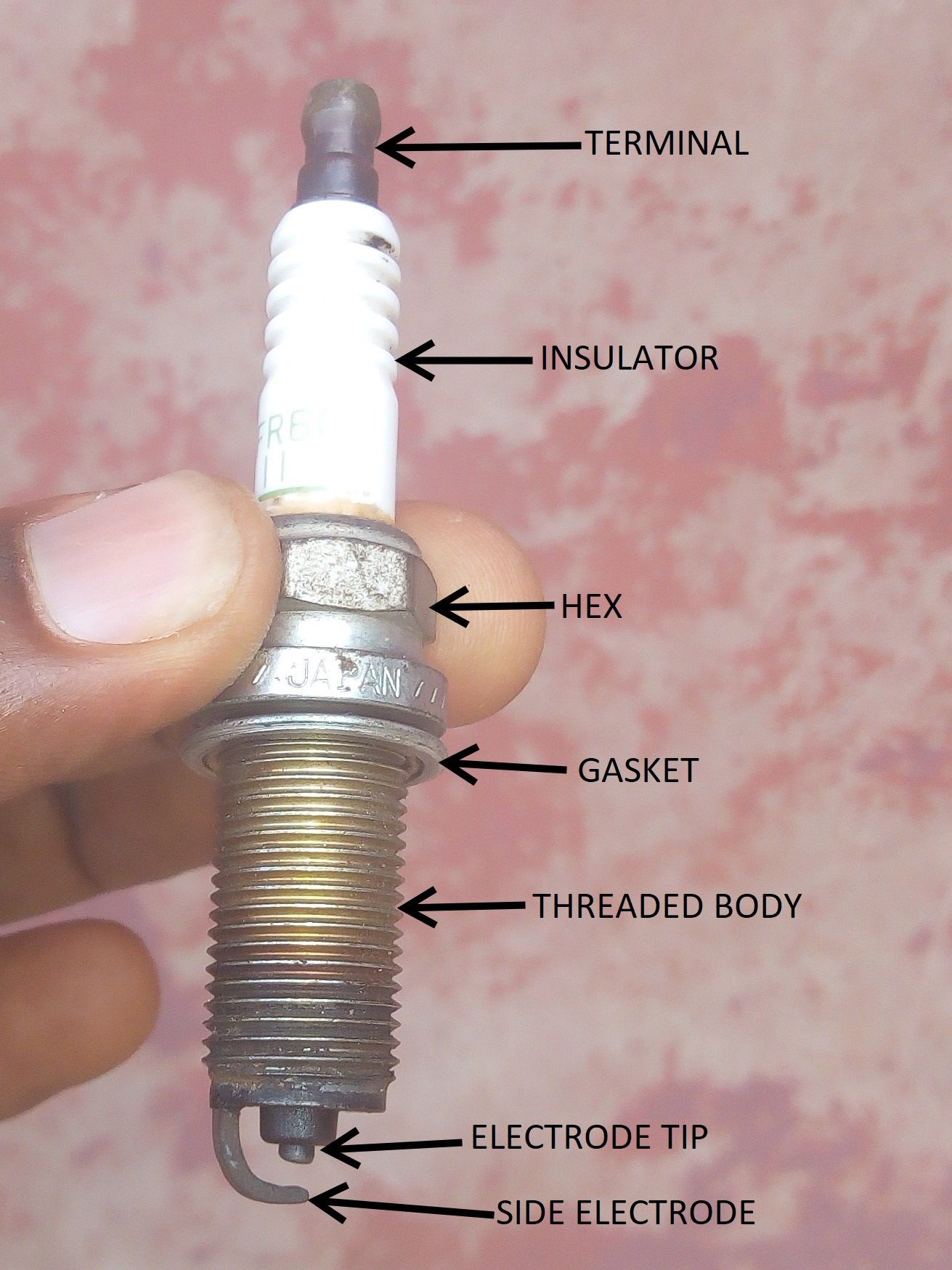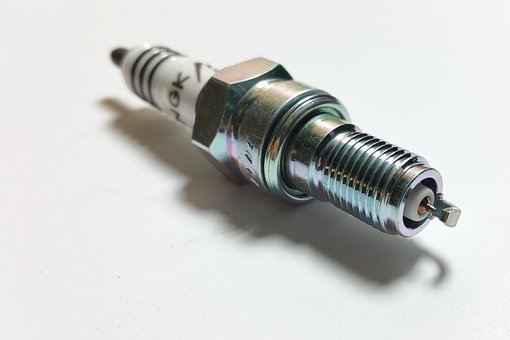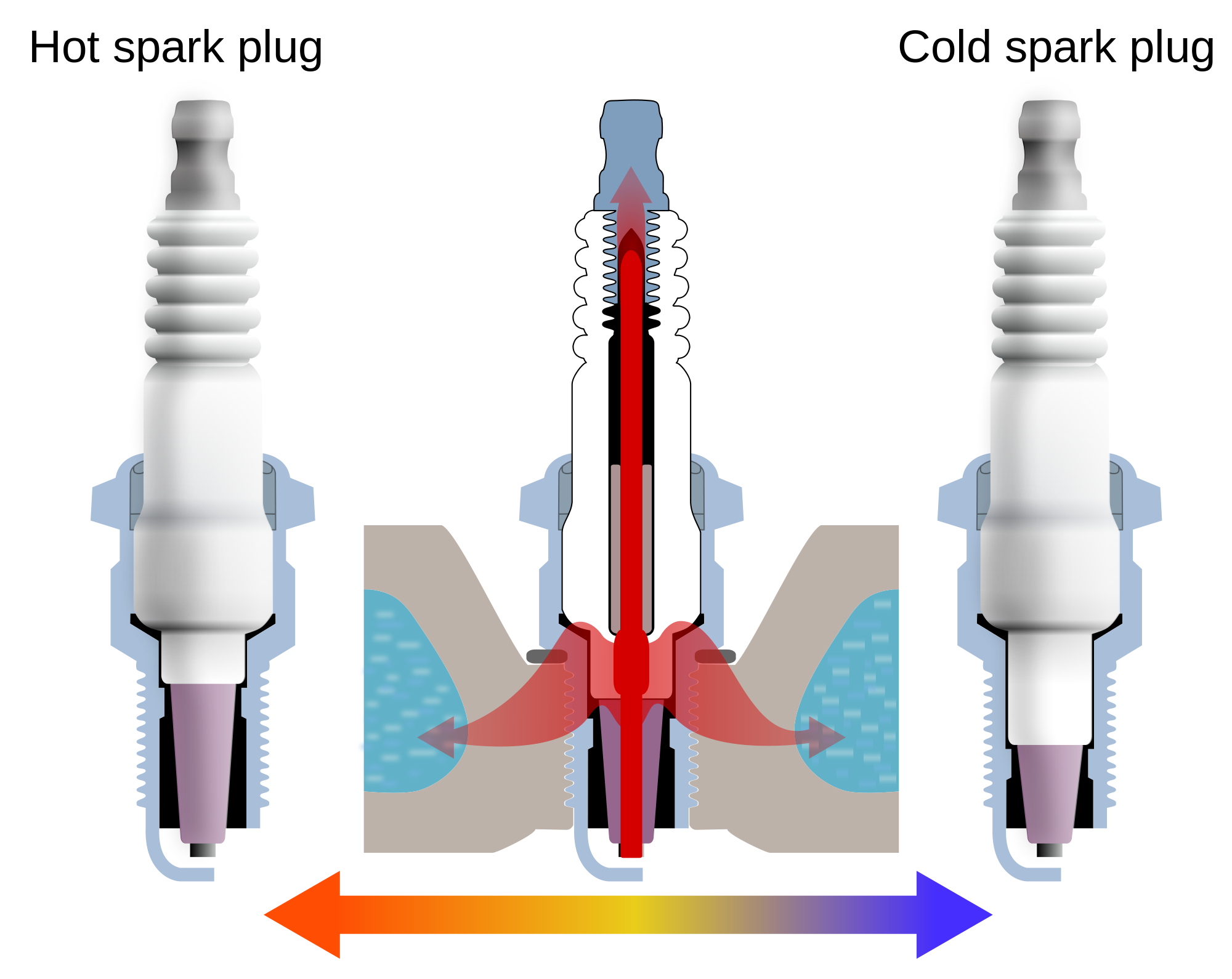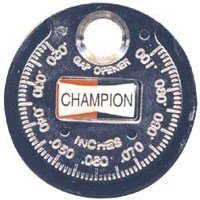THE SPARK PLUG; even the engine needs a spark in its life!
Hello everyone, welcome once again to my blog. Next time you are coming, please bring pizza.
Apart from reading the heading, I’m sure you would have guessed that his post would be another one about the automobile or the internal combustion engine. Well, you are right! Today, I would be talking about a part of the automobile engine (and other internal combustion engines) that is not so visible but VERY important. Yes, it is so important that I have to state the fact again.
Before I start, I would like to clear some ambiguity. The internal combustion engines of today can be classified based on the type of fuel they use or more extensively, by the type of ignition system they have. The classifications are: spark ignition and compression ignition engines. The major difference between the spark and the compression ignition system is the presence of the SPARK PLUG in the spark ignition and its absence in the compression. More details about the compression ignition can be seen in a post by @adetola here.
Another point I would like to establish is the importance of the power stroke in the operation of an internal combustion engine. If you read my post here you would notice that the power stroke starts with the ignition of the charge in the chamber. In the spark ignition engine, this ignition is done by introducing a spark into the combustion chamber. I would be talking about what is responsible for the spark – the spark plug, and how it does it. @adetola also did a post about the spark ignition engine cycle here. Yes, you are right, I have quite a number of friends that write about engines.
Well, simply to summarize;
the spark ignition system uses a spark to ignite the fuel in the combustion chamber while the compression ignition makes use of compression to ignite the fuel
An adage says “there is no smoke without fire” I strongly agree but come to think of it, is there a fire without a spark? Well I am quite sure the answer is NO. A spark can be gotten from quite a number of sources; from a match stick striking against a match box to the bright beam of light from a lightening. I wouldn’t want to say sparks are everywhere but wait, what if I do?
When it comes to the spark needed by the internal combustion engine (spark ignition type) the SPARK PLUG is “the man for the job”

image source: pixabay
THE SPARK PLUG
I would assume the spark plug is not a popular part of the engine, so I would present it as a non popular part of the engine.
The spark plug is actually a device that is part of the ignition system. In fact, it is a very important part of the ignition system. It is saddled with the duty of delivering an electric current supplied by the ignition system into the combustion chamber to ignite the charge during the power stroke.
The spark plug is also referred to as plug and was first used in the internal combustion engine in 1860 (those things have sure been around for a long time) by Étienne Lenoir.
The number of spark plugs in an engine is equal to the number of cylinders in the engine (I.e. a four cylinder engine is equipped with four spark plugs) each fitted at the top of the engine and connected to the ignition system.
the ignition system is made of the battery, alternator and the coils. The alternator charges the battery and the battery delivers electric power to the coil whose job is to multiply the voltage (by the principle of electromagnetic induction) and thus deliver a high voltage (as high as between 40,000 to 100,000 volts) to the spark plug.
However, apart from the function of delivering a spark to the combustion chamber, the spark plug also serves the purpose of dissipating heat from the engine. Although this is more of like a secondary function.
PARTS OF THE SPARK PLUG
As tiny or quite irrelevant the spark plug may look, it has some distinct parts that have very important roles in the operation of the spark plug and thus, the general performance of the engine. I case you do not know, a faulty spark plug would mean a non-starting engine but let’s not go to that yet. Starting from the top of the spark plug, here are the parts and the functions they carry out.

PHYSICAL PARTS PF A SPARK PLUG (Image taken and edited by me @rharphelle)
THE TERMINAL
As the name implies, this is the part of the plug that is connected to the conductor from the ignition system. The terminal is the first line of contact between the spark plug and the ignition. It runs all the way into the spark plug to the core of the center electrode.
THE INSULATOR
Physically inspecting the plug, one would see the insulator directly below the terminal. The insulator is made of a very hard ceramic material known as sintered aluminia. This is used because it has a very good heat conduction property. Its functions are to insulate and to support the central electrode.
The insulator literally houses the center electrode. The length of the insulator determines the heat range of the plug, with the shorter ones being the cold plugs and the longer ones, hot plugs.
THE HEX HEAD
A little lower, you would see the Hex-head which is where the wrench fits when the plug is to be tightened or loosened. Below the hex-head however is a gasket which performs the function of sealing off the combustion chamber (recall that the spark plug fits directly into the combustion chamber).
THE CENTRAL ELECTRODE
Lets take a dive into the middle of the plug, there you have the central electrode. It is connected to the terminal and runs all the way to the tip of the plug. The central electrode is one of the major parts of the plug as it is the part that releases the electrons.
THE SIDE ELECTRODE
This is also known as the “ground strap*. I call it the “other side” of the center electrode i.e. if the central electrode is the cathode, it is the anode! The spark delivered by the plug actually jumps from the tip of the central electrode to the ground electrode. The side electrode is connected to the metal body of the plug which is bolted to the cylinder head of the engine. There exists a gap between the side electrode and the tip.
HOW DOES THE SPARK PLUG WORK?
Just like the lighter in your gas cooker, the spark plug functions to deliver a spark that would cause combustion of a fuel. The way this spark is produced is explained as follows.
The ignition system comprises of the battery, alternator, the ignition coil and the spark plug. The battery/alternator delivers electric voltage which is multiplied by the coil. As a result of the structure of the plug and high insulation by the insulator, the high voltage travels straight down through the central electrode to the tip (now here comes the tricky part!) in order for a spark to occur, the electrons must jump from the tip of the electrode to the side electrode.
Recall that the center and side electrodes are not electrically connected thus, there is a high potential difference between them. The circuit is an open circuit as no current can flow between them and the air fuel mixture is quite an insulator.
As the voltage in the central electrode rises, the gases in the gap begin to change in structure and get ionized (more of like the corona effect). Ionization of the gases makes them a conductor and thus, electrons can flow through the gap. This flow of electrons is what comes as a spark that ignites the fuel (same way electrons are involved in the lightening).
This whole process occurs in seconds.
According to the principle of thermionic emission, electrons are easily emitted from hot surfaces and thus, the electrons have a field day as the plug is hot. Also the tip of the plug is usually pointed because electrons are best discharged at a point where there is smaller radius of curvature such as the sharp point or edge.

source: pxabay
TYPES OF SPARK PLUGS
All over the world, spark plugs have similar appearance and are easily identifiable when you see one. However, there are different ways by which spark plugs are classified and used. Classification can be based on the;
- TYPE OF ELECTRODE
This includes the copper/Nickel spark plugs which are often called the normal or standard spark plugs. The electrode is made of a copper core and a Nickel-alloy coating. This is because copper cannot withstand the high temperatures that the spark plug would be subjected to and would melt almost immediately it is exposed to heat.
The normal spark plug actually do not have a long life span or cost much. Yet, they are still used quite well because the copper in them is a good conductor and is known to deliver the best spark under adverse working conditions such as engines equipped with turbochargers or have higher compression ratios. In other words, the Nickel/Copper spark plug is very suitable for the older generation engines.
Another type of spark club is the PLATINUM SPARK PLUG. The platinum spark plugs make us of the rare element; “Platinum” and as a result of the rare nature of the element, the platinum plugs are more expensive. They are of two types - the single platinum and the double platinum plugs. the difference between the single and double Platinum plugs is that the “single” has only the center electrode made of Platinum while the “double” has platinum being both the center and ground electrode. As a result, the double platinum plugs are even more expensive.
Platinum plugs have a lot of advantages over the Nickel/copper plugs which include their long life span (almost twice that of Nickel/copper) under normal driving conditions, the fact that they do not erode easily due to their hardness, they also prevent the buildup of carbon as a result of the fact that they run at higher temperatures. The platinum spark plugs are often found in more modern vehicles as they can withstand the operating conditions.
A third classification based on type of electrode is the IRIDIUM SPARK PLUG. Well, as the name implies, the electrode is made of Iridium. These spark plugs also have a good reputation of helping the engine deliver a better output and smooth running. They also have a long life span but might not be as long as the Platinum plugs. However, the Iridium plugs cost the most.
- HEAT RANGE
Recall that the spark plug is directly fitting into the combustion chamber of the engine and thus is subjected to a lot of heat, and like I said earlier, the spark plug also performs the passive duty of conducting heat away from the engine and thus, spark plugs can also be classified based on their heat range. Simply put;
the heat range of a spark plug is the temperature at which the plug would work efficiently
In the event of a spark plug getting too hot during operation, the heat it accumulates might cause what is called “premature ignition” i.e. the air-fuel mixture ignites before the power stroke even before the spark is introduced by the ignition system. This can cause an engine knock.However, a plug that operates in a temperature lower than specified (too cold) would experience carbon buildup on the tip of the center electrode which would result in misfires or incomplete combustion of the fuel in the chamber.
According to heat range, spark plugs are classified as ”hot” or ”cold”.and this corresponds to the heat range they are made for. The major physical difference between the hot and the cold plugs is the length of the insulator tip.
The ”hot” plug has a longer insulator nose and thus a larger part of it is exposed to the heat which also means that the plug would have to hold the heat for longer before it is dissipated. As a result of this, the tip gets hot quickly.
On the flip side, the ”cold” plugs have a shorter insulator tip and thus, heat is dissipated faster.
You might be wondering which type of spark plug is best- the hot or the cold or probably Platinum, Iridium or Nickel/Copper. Well, the type of spark plugs suitable for an engine is actually specified by the manufacturer and should be strictly adhered to because a switch in plug type would definitely affect the engine performance. Switching spark plug type should only be done when there has been some engine modifications or a change in driving conditions and these should be as advised by a trained technician.
THE SPARK PLUG GAP
Years back, the spark gap of the plugs needed to be adjusted based on the engine specification. This “gapping” is done by adjusting the distance between the side electrode and the tip. A special tool known as the “gap gauge” (a disc with sloped edges).
Over the years, spark plug producers now produce plugs that have been gaped correctly and thus the gap gauge is no longer in use now. However, one could still use the gap gauge to check the gap of a plug in order to ensure optimum performance. A bigger gap usually causes ineffective ignition or poor response.
CONCLUSION
Once again, another crucial and important part of the internal combustion engine. I can authoritatively say that every part of the internal combustion engine is as important and a problem with one is usually a problem with the engine.
The spark plugs have been around since the invention of the internal combustion engines and are still relevant till this day. Their absence in an engine simply means the engine is not a spark ignition type. Spark plugs sometimes are said to last forever (in English, that’s called immortality) and the only thing that really affects them is the deposition of carbon on the tips.
Thank you once again for reading my blog, I am always overwhelmed by the comments I receive on my posts, it is always a joy to know that I have a good audience. If you are an old or intending member of the steemstem community, do well to make sure you place good comments on the posts of other authors in order to foster communication and community spirit among members. Have a nice day and I await your comments. Cheers!
REFERENCES
1. How spark plugs work
2. Spark plug
3. How do spark plugs work
4. Everything ypu need to know about spark plugs
5. Spark plugs
6. Understanding the different types of spark plugsspark plugs
If you write STEM (Science, Technology, Engineering, and Mathematics) related posts, consider joining #steemSTEM on steemit chat or discord here. If you are from Nigeria, you may want to include the #stemng tag in your post. You can visit this blog by @stemng for more details.



You are right.. The engine needs a spark to come alive. The essence of the spark plug is felt in everyday when using the car engine or ic engine.. They are very much useful..
I am glad i was able to know the parts and learn more about them today. Thanks a lot for this.
Thank you for reading through sir. Hope i would get pizza from you next time :)
😁😁😁 i don't like online food/snacks
I prefer us getting it in real life.
Oh well, you can arrange a meet
You own the idea.. I wouldn't like to steal what is not mine.
Hi @rharphelle its good to see people still tinkering with engines! Most people I know would not even be able to find the spark plugs :)
One thing I would have thought Iridium spark plugs have the longest life because of even higher resistance to corrosion as well as a higher melting point than Platinum?
Hello @terrylovejoy, the life span of these spark plugs is often a function of the application and operating conditions. but overall, the Platinum spark plugs are still preferred.
While i was working in an automobile workshop, i once took time to check online for the comparison between the two and from me, the Platinum spark plug wins. But it all boils down to the operating conditions.
Thank you
Recall that these spark plugs work best in engines they are specified for.
Another spark from the boss. Wouldn't we just name you the steemstem Mechanic for I have learnt a while lot about automobile from just your blogs.
This is another fabulous effort and I must agree that the spark plug as small as it could render a spark ignition type engine useless if it's bad.
Just learnt this. I didn't have the slightest of idea about it.
I have learnt a lot here. Thanks once again.
thank you very much for your kind comments. I am always exited to share my knowledge.
How does opening an automobile workshop here on steemit sound?
As for the name, i think i can keep it
cheers!
LOL, that would be fabulous...This might be the steem u've been looking for..I dont thin anyone is doing that here...Could be the Mech guys version of air-clinic
It is fabuloys already! Could evolve to be something big o...We mech guys could actually start that..We could get guys in the field in the steemstem grp and initiate it already
Nice idea sir, let's see how that goes.
That's a nice idea, worth the try!
Yeah, looking forward, wouldn't mind being a co-founder
Homage to little things. I really don't know how spark plugs work until now even though i have used it many times. Thanks for sharing
Thanks for reading sir
Spark plugs are indeed an important member of spark ignition engines - no spark plug, no power.
I wouldn't say I have no inkling about them, but I must confess that you have provided me with more knowledge.
The fact that the post answered every possible question even makes it more complete.
Well done sir.
Thanks for reading sir. Sometimes, the little detail we don't notice makes the difference.
All the glory goes to the engine for making our vehicle move but we fail to hail the spark plug for making the engine start.
Congratulations! Your post has been selected as a daily Steemit truffle! It is listed on rank 12 of all contributions awarded today. You can find the TOP DAILY TRUFFLE PICKS HERE.
I upvoted your contribution because to my mind your post is at least 7 SBD worth and should receive 95 votes. It's now up to the lovely Steemit community to make this come true.
I am
TrufflePig, an Artificial Intelligence Bot that helps minnows and content curators using Machine Learning. If you are curious how I select content, you can find an explanation here!Have a nice day and sincerely yours,

TrufflePighttps://www.youtube.com/paulbegley34